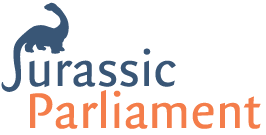Posts
Reader, I am over the moon about Jim Slaughter’s new book, Robert’s Rules of Order Fast Track. This brief, affordable and funny guidebook will give you the tools to apply Robert’s Rules immediately and effectively. Jim’s humor and focus kept me reading with enjoyment, underlining key phrases, and dotting the text with exclamation points. Jim…
Read MoreDear Dinosaur: A councilmember made a motion and no one seconded it. Should it be included in the minutes? Answer: This is a simple question with a slightly complex answer. Robert’s Rules of Order Newly Revised, 12th edition says that all main motions which are moved in the course of a meeting, except normally any…
Read MoreDear Dinosaur: Our local bylaws are old and have clauses that conflict with the latest edition of Robert’s Rules of Order. Does Robert’s Rules overrule the conflicting errors? Answer: No. Bylaws have higher authority than Robert’s Rules, so if the clauses conflict, in general, the bylaws take precedence (have authority). It is a good idea…
Read MoreI had the pleasure this summer of a lively conversation with Jim Hunt, host of “Amazing Cities and Towns” podcast. Jim is a former mayor and councilmember in Clarksburg, West Virginia, and past president of the National League of Cities. He brought a candid eye, wide experience, and sharp insights to our discussion. We talked…
Read MoreGuest post by Wayne Jennings, Ph.D. Jurassic Parliament is delighted to share this real-life example of how the students of Wayne Jennings, an innovative high school teacher, brought Robert’s Rules alive in their classroom. Meetings in schools Meetings involve a group in making important decisions. At the student-group level, elected or volunteer student officers run…
Read MoreOur faithful readers know that Jurassic Parliament advocates for action or summary minutes, not detailed minutes. This article, Meeting minutes record what is DONE, not what is SAID, explains our reasoning. We thought it might be helpful to provide a real-life example of each kind of minutes, so here they are. Robert’s Rules of Order…
Read MoreDear Dinosaur: At a recent board meeting, a motion was made and seconded and there was discussion. During discussion, another motion was made and seconded to delay consideration of the original motion until the next board meeting (we have monthly meetings). A challenge to this second motion was made stating that the original motion was…
Read MoreGuest article by Matthew J. Schafer, PRP Many organizations are incorporated in Washington State under the Washington Nonprofit Corporation Act. (This article will refer to this law as “the Act”.) During the 2021 session, the legislature repealed the existing Act and replaced it with a new one. These are some of the most important changes…
Read MoreIt seems that a lot of confusion prevails within our local government bodies about the Motion to Reconsider and how to use it. This article describes when and how to reconsider a motion, and other ways of changing your mind as a body. It was first published on the MRSC blog. MRSC is a private…
Read MoreWhat is the role of the mayor in discussion at city council meetings? The answer to this question is a bit subtle. Download PDF In a large council, mayor does not take part in discussion Robert’s Rules of Order says that in a large group, the chair of the meeting does not take part in…
Read More








